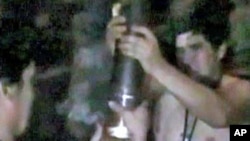Chile's government is sparing neither money nor trouble in supporting the 33 miners trapped by a cave-in on August 5. As part of that effort, they asked the United States' National Aeronautic and Space Administration, or NASA, to send specialists to advise local medical officers on the trauma of prolonged isolation. The NASA team traveled to Chile's Atacama Desert last week and briefed reporters afterwards.
Video released last week shows the miners receiving supplies like food and music - sent down a narrow tube from 700 meters above.
NASA specialists just back from the site say Chile has mounted an outstanding response following the discovery of the 33 miners, alive.
"They had done a lot for their own health before they were even found, and they had organized into groups and established a hierarchy among themselves," said Dr. Al Holland.
Dr. Al Holland is a NASA psychologist sent to Chile to help. He and his colleagues urged authorities there to focus not only on the challenge of rescuing the miners, but also on the often complex aftermath. Dr. Michael Duncan is a NASA doctor:
"When they come out of the mines that is just the beginning because they will have to be re-introduced to society and to their families," he said.
"This is an operation probably unprecedented in scope," said Dr. James Polk. "Never have people been trapped for so long so deeply."
Dr. James Polk, another NASA doctor, says Chile has done an excellent job introducing limited amounts of food to the miners. That, he says, can be tricky business.
"Re-feeding folks that have been starving is not a simple thing," he said. "In fact if done incorrectly it can be life-threatening."
It's recommended that the miners, in fact, not gain much weight so that their extraction through a narrow escape shaft will be simpler.
Family members have set up makeshift camps above the disaster site.
Last week, they waved flags and read aloud the names of their loved ones, marking one month since the mine collapsed on the men.
"Faith has not been lost," said Jose Vega, family member of a trapped miner. "I know we will get him out."
Helping family members hold onto that hope were survivors of a famous 1972 plane crash in the Andes mountains, where survivors ate their dead and were often in despair. Survivor Ramon Sabella urged families and survivors not to give up.
"It reminded me of when planes would fly over us and we would get close and then they would get farther away and the pain we felt and the frustration," said Ramon Sabella.
The miners could face months in isolation as engineers drill an escape shaft in what's expected to be one of the world's most challenging rescue operations.








